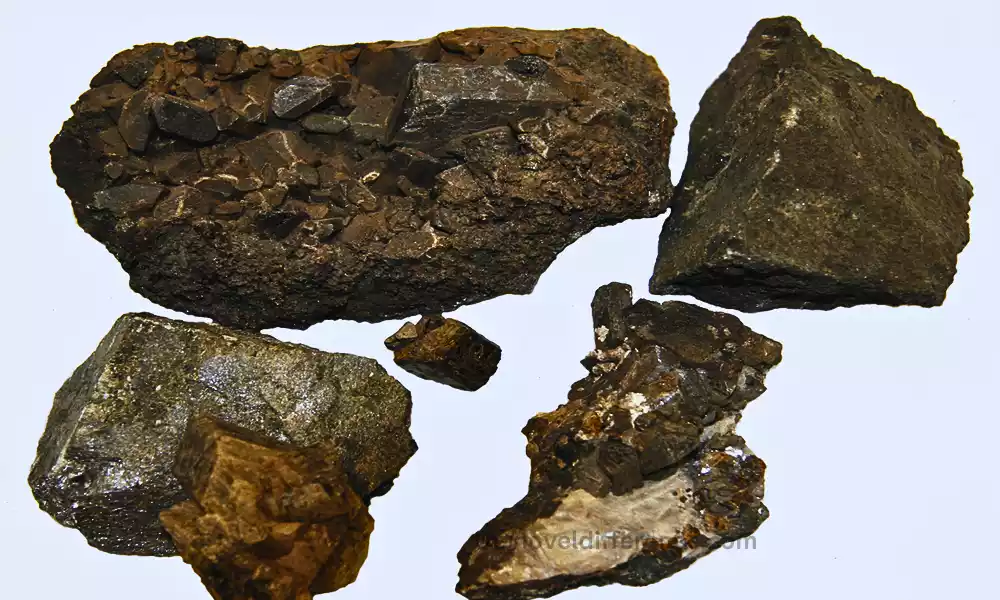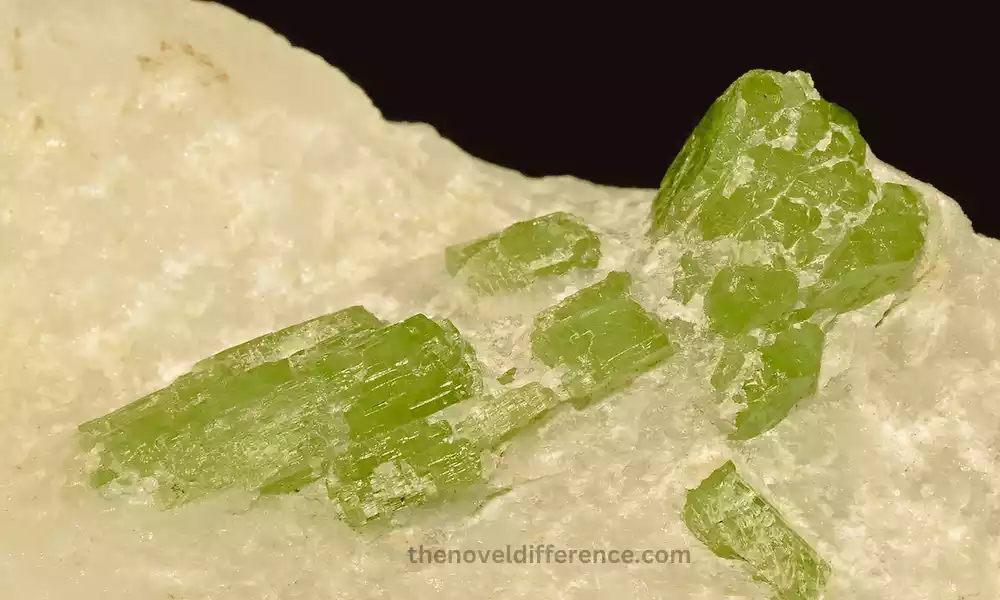Geology enthusiasts and students often encounter the terms pyroxene and amphibole when studying rocks and minerals. These two mineral groups have some similarities but have different properties. What sets them apart? We will explore the difference between pyroxene and amphibole. And will highlight their unique properties, structure, and uses.
Importance of Pyroxene
Pyroxene minerals are of significant importance in various geological and scientific contexts due to their distinctive properties and wide occurrence. These minerals form their single-chain silicates. Identifies igneous and metamorphic rocks, with different chemical compositions. which serve as valuable indicators for classifying them.
Their presence or absence, as well as their specific types, provide insight into the formation conditions and history of the rocks. Helps geologists reconstruct Earth’s past tectonic and thermal processes. Pyroxene also plays an important role in petrographic thin section analysis. Enables researchers to study mineral textures, identify mineral relationships, and estimate the thermal and stress conditions of rock formations.
Beyond the limits of geology, pyroxenes account for their high-temperature stability and desirable physical properties. which finds application in various industries including ceramics, glass, and refractories. So, the study and understanding of pyroxene minerals unravel the geologic history of the Earth. Contributes significantly to facilitating industrial processes and advancing scientific research.
Importance of Amphibole
Amphibole minerals play a distinct and important role in geology and beyond due to their unique properties and versatile applications. These double-chain silicate minerals are metamorphic from igneous. which are integral indicators in understanding the formation and evolution of different types of rocks.
Their presence, composition, and distribution provide important clues about geological processes. which shaped the earth’s crust over time. Amphiboles are key components of petrographic thin sections. Helps geologists unravel the history of complex rocks. Understand mineral relationships and determine pressure and temperature conditions during rock formation.
Their significance extends beyond geology; Some amphibole varieties, such as asbestos minerals, have raised concerns because of associated health risks. Asbestos-related diseases require precautionary measures to ensure human safety. Despite these challenges, amphibians find utility in construction materials, industrial applications, and scientific research.
The study of amphibole minerals not only enriches our understanding of Earth’s geological past. Rather it also underscores the importance of responsible mineral use and the advancement of knowledge for both scientific and societal benefits.
What is Pyroxene?
Pyroxene refers to a group of important rock-forming minerals. which are characterized by their single-chain silicate structure and different chemical compositions. These minerals play a fundamental role in geology. Because they are commonly found in various igneous, metamorphic, and occasionally sedimentary rocks.

Pyroxenes exhibit a variety of physical characteristics, with color variations ranging from green and brown to black. As a result, they often exhibit distinct cleavage planes. Their hardness and density make them the strongest material in many rock types. Augite, enstatite, and diopside are some of the well-known pyroxene mineral varieties. Each of which has a specific chemical composition and crystal structure.
which helps geologists decipher the geological history of the Earth’s crust. They have prevalence and importance in rock classification and petrographic analysis. Pyroxene minerals have shaped our planet for millions of years. thereby serving as an invaluable tool for understanding a dynamic process.
What is Amphibole?
Amphibole refers to a significant group of double-chain silicate minerals. which holds an important place in the field of geology and physical science. They are characterized by their elongated crystal structure and variable chemical composition. Amphibole minerals are commonly found in a wide range of geologic settings, from igneous and metamorphic rocks to hydrothermal veins.

They have different colors, cleavage patterns, and optical properties. Which makes them distinctive and easily identifiable. Amphiboles play an important role in petrological studies. Helps geologists determine the pressure and temperature conditions during rock formation. and provides insight into geological processes.
which shaped the earth’s crust. Notably, some amphibole varieties such as hornblende, actinolite, and tremolite have industrial applications. which accounts for their unique physical properties. which finds use in construction materials, heat-resistant products, and insulation.
So, amphiboles, especially those containing asbestos, also raise health concerns due to their association with respiratory diseases. The study of amphibole minerals not only improves our understanding of Earth’s geologic history. But also emphasizes the need for responsible mineral use to ensure the safety of both human health and the environment.
Difference Between Pyroxene and Amphibole
| Aspect | Pyroxene Minerals | Amphibole Minerals |
|---|---|---|
| Chemical Composition | Single-chain silicates | Double-chain silicates |
| Crystal Structure | Single-chain structure | Double-chain structure |
| Cleavage Patterns | Generally at 90° angles | Varies in angles |
| Color Range | Green, brown, black, and others | Variable colors |
| Luster | Vitreous to dull | Vitreous to dull |
| Transparency | Usually translucent to opaque | Variable transparency |
| Common Types | Augite, Enstatite, Diopside | Hornblende, Actinolite, Tremolite, and others |
| Petrological Significance | Indicators of rock type and formation conditions | Insights into geological processes and rock history |
| Thin Section Analysis | Aids in rock texture and history interpretation | Provides information on pressure and temperature conditions |
| Industrial Uses | Less common in industrial applications | Heat-resistant materials, construction, insulation |
| Health Concerns | Generally low health risk | Asbestos-related health risks, requiring careful handling |
| Geological Occurrence | Igneous, metamorphic rocks | Various geological settings |
| Optical Properties | Pleochroism can be present | Variable optical characteristics |
| Overall Importance | Valuable for rock classification, geologic history, and petrology | Crucial for understanding geological processes, material applications, and health concerns |
Please note that this chart provides a simplified overview, and there may be more nuances and variations within each mineral group.
Geological Occurrence and Uses
Here’s a more detailed breakdown of the geological occurrence and uses of both pyroxene and amphibole minerals:
Geological Occurrence:
Pyroxene Minerals:
- Pyroxene minerals are commonly found in a variety of igneous rocks, including basalts, gabbros, and peridotites.
- They are also present in some metamorphic rocks formed under high temperature and pressure conditions.
- Pyroxenes can occur in certain types of meteorites as well.
Amphibole Minerals:
- Amphibole minerals are often found in igneous rocks like granites, diorites, and syenites, where they form secondary minerals during the cooling of magma.
- They are particularly prevalent in metamorphic rocks, such as schists, gneisses, and amphibolites.
- Amphiboles can also occur in hydrothermal veins, formed through the interaction of hot fluids with pre-existing rocks.
Uses:
Pyroxene Minerals:
- Pyroxene-rich rocks like basalt have been used as construction materials, particularly as paving stones or in road construction.
- Certain pyroxenes, like augite, can be used as gemstones when cut and polished due to their attractive colors.
- Pyroxene minerals also have applications in refractories, ceramics, and as fillers in various industrial products.
Amphibole Minerals:
- Amphiboles like hornblende have been used in construction for their durability and resistance to weathering.
- Some varieties of amphiboles have been utilized as ornamental stones or in decorative sculptures.
- Certain amphibole minerals have heat-resistant properties, leading to their use in fire-resistant materials and heat shields.
- Tremolite and actinolite asbestos, both types of amphiboles, were used in various industries for their heat resistance and insulation properties. However, their health risks have led to strict regulations and reduced usage.
It’s important to note that while these minerals have been historically used in various applications, their utilization has changed over time due to concerns about health, safety, and environmental impact, particularly in the case of asbestos-containing amphiboles.
Environmental and Health Considerations
Pyroxene Minerals:
- Pyroxene minerals themselves are not typically associated with significant environmental or health concerns.
- However, mining and processing pyroxene-rich rocks for industrial purposes can have environmental impacts, such as habitat disruption and air and water pollution if not managed properly.
Amphibole Minerals:
- Certain varieties of amphibole minerals, such as tremolite and actinolite, have been associated with asbestos, which poses serious health risks when its fibers are inhaled. Asbestos exposure has been linked to lung diseases, including asbestosis and lung cancer.
- Due to these health risks, the mining, processing, and use of asbestos-containing amphibole minerals have been heavily regulated or banned in many countries.
- Asbestos-containing materials used in construction and insulation can release harmful fibers into the air if they deteriorate, which can pose health risks to occupants.
Conclusion
Understanding the difference between pyroxene and amphibole is essential for geologists, mineral enthusiasts, and those interested in Earth’s geologic history. The unique properties, composition, and uses of these minerals contribute to the diverse tapestry of our planet’s composition. When you explore rocks and minerals. Then note the distinctive features that distinguish pyroxene and amphibole. Increases your appreciation for the world beneath your feet
